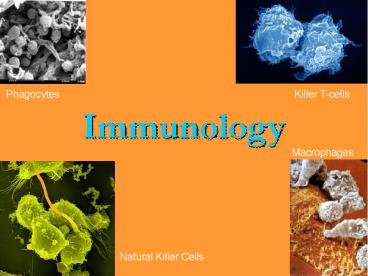Immunology - PowerPoint PPT Presentation
Title:
Immunology
Description:
Phagocytes Killer T-cells Immunology Macrophages Natural Killer Cells Immune System Group of cells in the body that recognize foreign substances F(x) = to neutralize ... – PowerPoint PPT presentation
Number of Views:200
Avg rating:3.0/5.0
Title: Immunology
1
Immunology
Phagocytes
Killer T-cells
Macrophages
Natural Killer Cells
2
Immune System
- Group of cells in the body that recognize foreign
substances - F(x) to neutralize or destroy all things
non-self (pathogens or invaders)
3
What is a Pathogen?
- Any toxin, living organism, or other agent that
can cause disease.
4
Immune Cells
- Immune cells circulate throughout the body in the
blood system and the lymphatic system
5
Lymphatic System
- A network of vessels that penetrate nearly every
tissue of the body, and a collection of tissues
organs that produce immune cells - F(x)
- Fluid recovery from tissues
- Lymph fluid
- Immunity
- Lymph is filtered before returning to blood
6
Lymph Tissues Organs
- Lymph Nodes
- Clean the lymph alert the immune system to
pathogens - Tonsils
- Guard against ingested orinhaled pathogens
- Thymus
- Produces T-cells
- Spleen (largest Lymph Organ)
- Monitors blood for foreign objects
- Recycles old RBCs
TONSIL
7
Body Defense
- - Two Types
- Non-Specific
- Specific
8
Non-Specific Body Defense
- Innate or inborn, not affected by prior exposures
- NOT specific for any invader
- Operates constantly
9
Non-Specific Body Defense
- SKIN 1st Line of Defense
- Physical barrier prevents entry of pathogens
- Must beunbroken tobe effective
- Acidic, oily, sweat glandsinhibitsbacterial
growth
10
Non-Specific Body Defense
- MUCUS MEMBRANES
- Respiratory,Digestive,Urinary,Reproduction
tracts - F(x)
- To trap debris pathogens
11
Non-Specific Body Defense
- HAIRS
- Nasal passage
- Traps debris pathogens
- CILIA
- Upper Respiratory Tract
- Traps debris pathogens
12
Non-Specific Body Defense
- CELLULAR DEFENSE
- Activated when other defenses are breached
- Two Types
- Phagocytes
- Leukocytes
Phagocyte eating dying cells.
13
Phagocytes
- Cells that recognize non-self items
- F(x) engulf or eat foreign debris
- Reside in lymph organs
- Travel to the site of infection, via the blood
stream - Macrophage a type of phagocyte
14
(No Transcript)
15
Leukocytes (Natural Killer Cells)
- a.k.a. NK Cells
- WBCs police the blood lymph
- F(x)
- Bind to membrane of the invader, release
chemicals, cause infected cell to lyse
16
Non-Specific Body Defense
- CELLULAR (TISSUE) DEFENSE
- Inflammatory Response
- Fever
17
Inflammation
- Local defensive response to tissue injury of any
kind - Response is directly at site of injury
- Helps to prevent spread of the damaging agent
18
Inflammation
- The 4 Signs of Inflammation S.H.A.R.P.
- Swelling
- Heat
- ?
- All four of these due to fluid build-up
- ?
- Redness
- Pain
19
(No Transcript)
20
(No Transcript)
21
Fever
- Abnormal elevation in body temp.
- Response to infection
- Stimulates phagocytes to go to work
- Heat kills many pathogens
- Increases the rate of enzymatic rxns
22
Non-Specific Body Defense
- CHEMICAL DEFENSE
- Interferons (antiviral proteins)
23
Interferons
- Secreted by virus-infected cell
- Stimulates non-infected cells to make proteins
that block viral protein synthesis - Slows infection to allow specific defenses to
begin working - Activates macrophages to eat (non-self) viral
invaders
24
Specific Body Defense
- Immunity ability to ward off a specific
infection or disease - Highly specific resistance to disease
- Process
- Particular invader recognized
- Switches on immune response
- Invader is remembered so that future invasions
can be immediately fought
25
Specific Body Defense
- Specific Body Defense is born out of the
Lymphatic System - i.e. Bone marrow ? makes B-cells, which make
specific antibodies
26
Antigens
- Irritant or pathogen molecule that react with
antibodies - Epitope region of antigen recognized by a
specific antibody - Stimulates formationof antibodies
27
Antibodies
- Molecules that react with or bind to antigens
- Mark antigens for destruction by macrophages
- Form due to the exposureto a specific antigen
28
Antibodies
- Made by B-cells
- Found in plasma, all body secretions
- Once present, allows immediate immune response to
pathogens
29
Antibodies
- Structure (most common)
- Composed of 2 heavy chains, 2 light chains
- Constant Variable regions
- Antigen-binding site
Variable region
Constant region
30
Specific Body Defense
- Helper T-cells
- Attract other T-cells (Killer T-cells) and
macrophages to an antigen - Killer T-cells
- Directly attack kill pathogens, release
chemicals to lyse cells
31
Specific Body Defense
- Suppressor T-cells
- Stops immune response when antigen is
successfully overcome
Scanning Electron Micrograph of a T-cell
32
- Specific Non-specific Defenses work
- together to protect the body from
- disease-producing pathogens
- B-cells mature in bone tissue
- T-cells mature in thymus tissue
33
Applications of Immune Response
- Immunization process that increases an
organisms rxn to antigen therefore improves
its ability to resist or overcome infection. - Vaccine living or inactivated organism
- used to induce specific immunity
34
Vaccines
- Attenuated agents
- Virus/bacteria that has beenmodified to be
incapable ofcausing disease - Inactivated agents
- Pieces or a whole organism that has been
chemically inactivated - Cant reproduce but retains antigenicity
35
Immunity
- 3 Types
- Active
- Passive
- Cell Mediated
36
Active Immunity
- When an individual responds to an antigen
- Resulting from vaccination against or
- Recovery from a natural infection
- Permanent Immunity
37
Passive Immunity
- Antibodies produced from another organism
injected into the body - Temporary protection against disease
38
Cell-Mediated Immunity
- Killer T-cells attack any cell not marked with a
special protein(i.e. cells that are non-self)


























![DOWNLOAD [PDF] Basic Immunology: Functions and Disorders of the Immune PowerPoint PPT Presentation](https://s3.amazonaws.com/images.powershow.com/10075840.th0.jpg?_=20240710027)


![[PDF] DOWNLOAD EBOOK Immunology: A Comprehensive Review PowerPoint PPT Presentation](https://s3.amazonaws.com/images.powershow.com/10131967.th0.jpg?_=202409170511)

